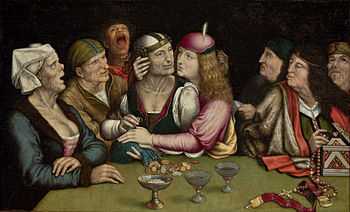Ill-Matched Marriage
 | |
| Artist | Quentin Matsys |
|---|---|
| Year | 1525–1530 |
| Type | Oil on panel |
| Dimensions | 54 cm × 89 cm (21 in × 35 in) |
| Location | São Paulo Museum of Art, São Paulo |
The Ill-Matched Marriage (also known as The Marriage Contract) is an oil painting executed by the early Netherlandish master Quentin Matsys, usually dated between 1525 and 1530. The panel, probably inspired by an original lost drawing of Leonardo da Vinci, illustrates an appealing subject in the history of art: the marriage for economic reasons between persons of different ages. The painting is housed in the São Paulo Museum of Art. It was donated to the museum in 1965 by the Baron Hans Heinrich Thyssen-Bornemisza.
Context and iconography
.
The marriage for economic reasons between persons of different ages has always been an appealing subject in the history of art, for being useful in the rendering of a social critic of strong visual impact. Many artists such as Goya, Leonardo da Vinci, Dürer and Lucas Cranach the Elder have dedicated works and studies to this subject. It is more common the representation of an old man marrying with a younger woman, often led to matrimony by the interest of the family. Matsys himself made another version of this theme, in conformity with this iconographic tradition - currently housed in the National Gallery of Art, in Washington. But in this Ill-Matched Marriage the opposite happens: a rich old woman marries a young man.
The old title of this painting was The Marriage Contract. The current title seems more adequate for its bigger precision and because the illustrated subject fully belongs to the Renaissance iconography of the Sposalizio Grottesco ("Grotesque Marriage", in Italian), largely spread in the Italian painting of the 15th and 16th centuries.
Matsys' narrative is solid and doesn't give occasion to doubts. Meanwhile being caressed by the young man, the old lady offers him a wedding ring with her right hand and, at the same time, opens her bag, smoothed by the man's left hand. The mockery, hypocrisy and the foolishness temper of the scene is highlighted by the burlesque features of the characters and, in particular, by the figure at the left, represented in the ambiguous act of putting inside a box the necklace spread on the table.
The subject of the "grotesque marriage" is also present in the satirical literature, as in the poem The Ship of Fools by Sebastian Brant (1494), which in its 52nd chapter, tackles about the "marriage-for-money" theme. The subject is resumed, brimful of mockery and humor, by Erasmus of Rotterdam, in his The Praise of Folly (1509).